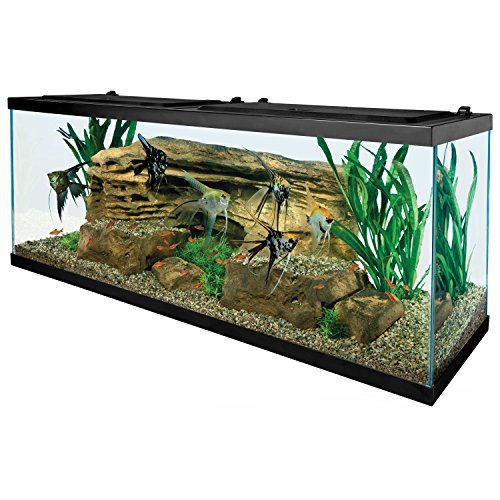
Fish tanks have become increasingly popular among both beginners and experienced aquarium enthusiasts.
They provide a window into the vibrant and fascinating underwater world, allowing us to create a serene and captivating environment in our own homes.
However, it is essential to understand the weight of a fish tank to ensure proper setup and prevent any potential disasters.
Understanding the concept of gallon measurement
Gallons and their significance in aquariums
Before we dive into the weight of a 55-gallon fish tank, let’s clarify what exactly a gallon is. In the context of aquariums, a gallon is a unit of measurement used to determine the size and capacity of the tank.
In simple terms, it measures the volume of water the tank can hold. The gallon capacity directly affects the overall weight of the tank, as larger tanks with higher gallons can hold more water.
Relationship between gallon size and tank dimensions
The size and shape of a fish tank can vary depending on its gallon measurement. A 55-gallon fish tank, for example, typically has dimensions of approximately 48 inches in length, 13 inches in width, and 21 inches in height.
While these measurements provide a general guideline, the actual dimensions may vary slightly between different manufacturers. It’s essential to keep in mind that the weight of the tank will depend on both its size and the materials used in its construction.

Factors affecting the weight of a fish tank
Materials used in tank construction
The weight of a fish tank is influenced by the materials used in its construction. Tanks typically consist of glass or acrylic, each with its own weight characteristics.
Glass tanks are generally heavier and more robust, while acrylic tanks are lighter but can still offer considerable strength.
Additionally, the tank’s frame and stand, usually made of metal or engineered wood, provide additional support and contribute to its overall weight.
Substrate and decorations
The weight of a fish tank is not limited to just the structure itself. The substrate, such as gravel or sand, and decorations, such as rocks and driftwood, can add significant weight to the tank. It’s important to account for these additional elements when considering the total weight of a 55-gallon fish tank.
Water volume and density
One of the significant contributors to the weight of a fish tank is the water itself. Water is relatively heavy, weighing approximately 8.34 pounds per gallon. With a 55-gallon tank, you can expect the water alone to weigh around 459 pounds. It’s essential to consider this when determining the overall weight the tank will exert on its support structure.
Equipment and accessories
Fish tanks often require various equipment and accessories, such as filters, heaters, and lighting systems. These additional components can significantly impact the overall weight of the tank. It’s crucial to account for the weight of these items and ensure that the support structure can handle the combined load.

Determining the weight of a 55-gallon fish tank
Calculating the weight of an empty tank
To determine the weight of a 55-gallon fish tank, start by considering the weight of the empty tank itself. This will primarily depend on the materials used. Glass tanks tend to be heavier, with an empty weight of approximately 60-100 pounds, while acrylic tanks are lighter, weighing around 30-60 pounds.
Considering the weight when filled with water
As mentioned earlier, water weighs approximately 8.34 pounds per gallon. With a 55-gallon tank, the water alone would weigh around 459 pounds.
Accounting for additional weight from substrate and decorations
If you plan on adding substrate and decorations to your tank, their weight needs to be taken into account. Gravel, rocks, and other decorations can add an additional 10-50 pounds to the total weight.
Including the weight of equipment and accessories
Lastly, factor in the weight of any equipment and accessories you plan to use, such as filters, heaters, and lighting systems. These can add an extra 5-30 pounds, depending on the specific items chosen.

Custom Tank Weight: Don’t Get Soaked!
Calculating the weight of a custom-shaped aquarium, especially one intended for ornamental fish, involves more than just cubic inches.
Each gallon of water adds 8.34 pounds, and substrate, decorations, and the weight of the fish themselves further add weight to the total.
Ensure your stand has ample surface area and extra support to handle this cumulative weight, which could easily reach one ton!
Managing the weight of a 55-gallon fish tank
Choosing an appropriate location
When setting up a 55-gallon fish tank, carefully choose a location that can support the weight. Ensure that the floor is level, sturdy, and capable of supporting several hundred pounds. Avoid placing the tank near weak spots, such as uneven flooring or areas with insufficient structural integrity.
Distributing weight evenly
To prevent excessive stress on the tank and stand, distribute the weight evenly. Ensure that the tank sits squarely on the stand and use leveling pads or shims if necessary to achieve a stable and balanced setup.
Strengthening support structures
If you anticipate a particularly heavy setup or have concerns about the stability of the support structure, consider reinforcing it. Additional supports, braces, or even consultation with a professional contractor may be necessary to ensure the tank’s weight is properly managed.

Small Aquariums Tank Size and Big Weights: Know Before You Buy
Even small aquariums can become surprisingly heavy. Consider the weight of water (8.34 pounds per gallon) when choosing a tank, and factor in the added weight of substrate, decorations, and any aquatic life you plan to keep.
A seemingly small aquarium can put significant stress on a surface, so ensure adequate support to avoid any accidents. Also, keep in mind that the surface area of the water in the tank will determine how many fish you can stock. Remember, the beauty of an aquarium shouldn’t come at the cost of safety!
Frequently asked questions about 55-gallon fish tank weight
Can the weight of the tank cause damage to the floor?
Yes, a poorly supported tank or incorrect distribution of weight can damage the floor, especially if it is not strong enough to handle the load. It’s crucial to ensure the tank is placed on a solid and level surface.
How does the weight affect transportation and installation?
Transporting a 55-gallon fish tank requires caution due to its weight. It is best to have multiple people to assist in lifting and moving the tank safely. During installation, follow proper guidelines to ensure the tank is set up securely and does not pose a risk to you or your aquatic life.
What precautions should be taken when moving the tank?
When moving a 55-gallon fish tank, it is critical to drain the water completely and remove all fish and decorations. Carefully lift the empty tank, taking care not to strain your back or cause damage to the tank. Have a plan in place for safely transporting the tank and make sure the new location is prepared before reinstalling it.
Conclusion
In conclusion, understanding the weight of a 55-gallon fish tank is crucial for maintaining a safe and secure environment for your aquatic life. Factors such as the tank’s construction materials, water volume, substrate, decorations, and equipment all contribute to its overall weight.
By properly calculating and managing the weight, you can ensure that your tank is supported adequately and prevent any potential issues. Remember to choose a suitable location, distribute the weight evenly, and strengthen the support structure if necessary.
By following these guidelines, you can enjoy the beauty of your fish tank while ensuring the safety of both your fish and your home.


